February 5, 2010
A family legend tells that in the late 1700s, an ancestor was scalped by the Catawba and Edisto tribes on Edisto Island, South Carolina, along the shores of the Edisto Creek. This branch of the family had recently fled a village in County Antrim right before that town’s most notorious series of witch trials and persecutions. I wonder whether – during their long months at sea – they envisioned a peaceful new land, or simply resolved that this time, they would be on the winning side. Never again tied to any stake, they would henceforth hold the match?
Due to the mangled condition of my ancestor’s body, the rest of the party could not bring it inland for burial, and thus he received a hurried and anonymous internment in the swamps, his body sinking deeply into the muddy guts of Edisto. I’m not saying he deserved to die, but I can’t imagine he didn’t have it coming to him. The tribes were here first.
And there his story would have remained – utterly un-eulogized – had his descendent of many centuries (me) not married into a family possessed of a cottage on Edisto Island, built approximately over the grave of my executed ancestor.
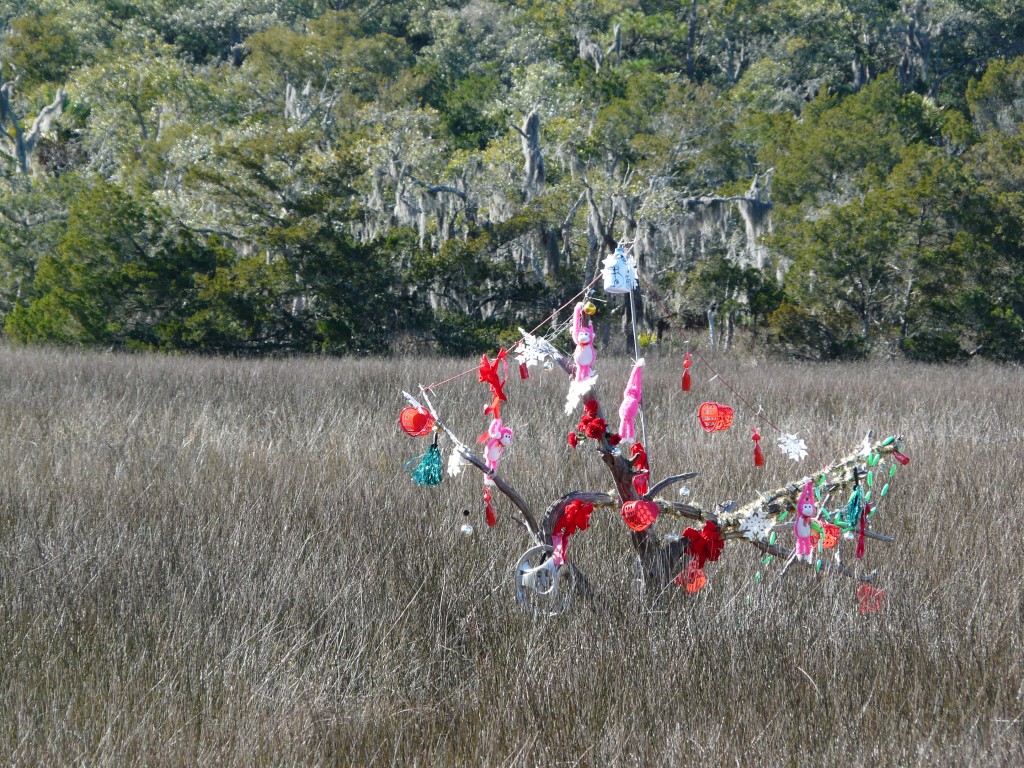
EDISTO ISLAND MYSTERY BOTTLE TREE
In January, I spent a few days on Edisto. Deep winter means rains, and an occasional star-spun night where owls call out to one another through the drooping moss. In the morning, beads of light entwine themselves within the pulled threads that run along the palmetto fronds.
I took my cameras to play with these beads of light.
It had been suggested that I go to Botany Bay Plantation, where the arches of oak create a cathedral ceiling over a dim and murky lane. Stopping off en route, I chatted with a local Gullah woman, who – for a brief instant – nearly invisibly flinched when I mentioned where I was going. For an unshuttered moment, a palpable flash of pain lit past her eyes and skin, and then moved to someplace deeper.
I understood the instant I arrived at the main lane. All is calm on the small local highway SC-174, and then a knowledge of something awful hits: to the left, the mile-long tree-lined entrance to the former Bleak Hall Plantation and Sea Cloud Plantation. To the right – dotting the “i” of the plantation lane – a magnificent bottle tree rose up from the swamps.
Protective, shamanic, and memorializing, bottle trees mean Something Here Is Wrong.
As in right versus wrong. As in: something wicked this way comes.
Bottle trees are a rebuke. A warning. A source of promise and protection: not here.
Intentional or inadvertent, this particular bottle tree – placed at the entrance to one of the most notable, wealthiest and cruelest plantations in the South – is an American monument to one of our land’s very first crimes against humanity. (For many on Edisto, apparently, just another colorful local custom during the Glory Days.)
Charleston was North America’s most significant port for the Atlantic slave trade, and Edisto Island had a particularly foul role, related in stories of unique brutality. The road leading in to Botany Bay Plantation has even more of a role – and hardly one that fulfills the American dream. A killing field initially run by a man named Baynard, whose slaves could be recognized by the degree of physical scarring, dismemberment, and disfigurement.
The bottle tree marks the point where people captured in Congo, Angola, Senegal, Gambia, and Guinea-Bissau were dragged in by Baynard up the lane. Right there at the bottle tree. The cruelty at the later Seabrook and Townsend plantations of Sea Cloud and Bleak Hall caused hundreds of enslaved Africans to die of disease, neglect, torture, and being worked to death. Now their land is called Botany Bay Plantation, and it’s an ecological preserve, game hunting park, and the houses themselves are no more.
At the time, there were more than enough people – even then – who knew the dehumanizing treatment of Africans in the Americas was wrong: the earliest Americans saw themselves poised at the inception of a fresh atrocity, yet moved forward into it.
What did these earliest Americans – black and white – know about this site, now marked by a bottle tree?
And of what has this particular bottle tree come back to remind us?
The placement of the tree seems to me a signal flare to the otherwise uncaring and oblivious contemporary culture: injustice happened here. Pain. Cruelty. Tremendous grief.
Let the evil that caused it travel no further.
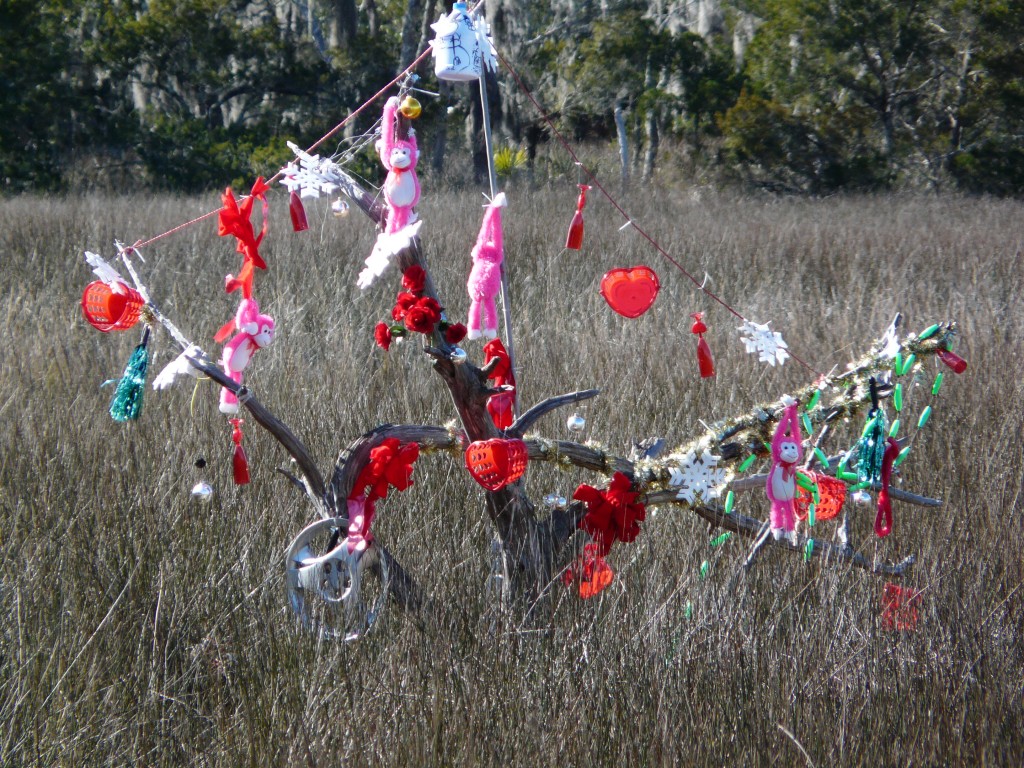
EDISTO ISLAND MYSTERY BOTTLE TREE
I grew up all over the South, and as a child I learned that bottle trees signify something far from decorative. They are a protest, and they are not mute.
Enslaved Africans brought this practice to America. To make a bottle tree, branches of a cedar or crepe myrtle tree (or whatever tree is available) are inserted into the mouths of empty glass bottles, or else a dead tree is brought from elsewhere, fixed into a spot of soil, and bottles placed within its branches. Often blue bottles, but any kind will do.
They are placed in a spot where evil is known to dwell, or visit, or pass by.
This hate is attracted to beauty, to grace, to mystery, to love- those are the evolved qualities that hate seeks to destroy. And so at night it crawls up inside to see what it can destroy. But it’s trapped inside by the reflections and refractions, and in the darkness can’t find its way out.
When the sun rises and illuminates the bottle, the hate is destroyed.
Bottle trees not only testify to a belief that hate can be lured, trapped, contained and destroyed – they also say we can take an active role in hunting it.
A good bottle tree makes a fence – a protective barrier that traps evil before it can get any further. Like in your back door with a burning cross, or a pointy white hood, or a flaming stick thrown through your child’s window.
Symbolic or literal, it is a shout out into the universe: NO.
Bottle trees are a sign of war: we will not sit idly by.
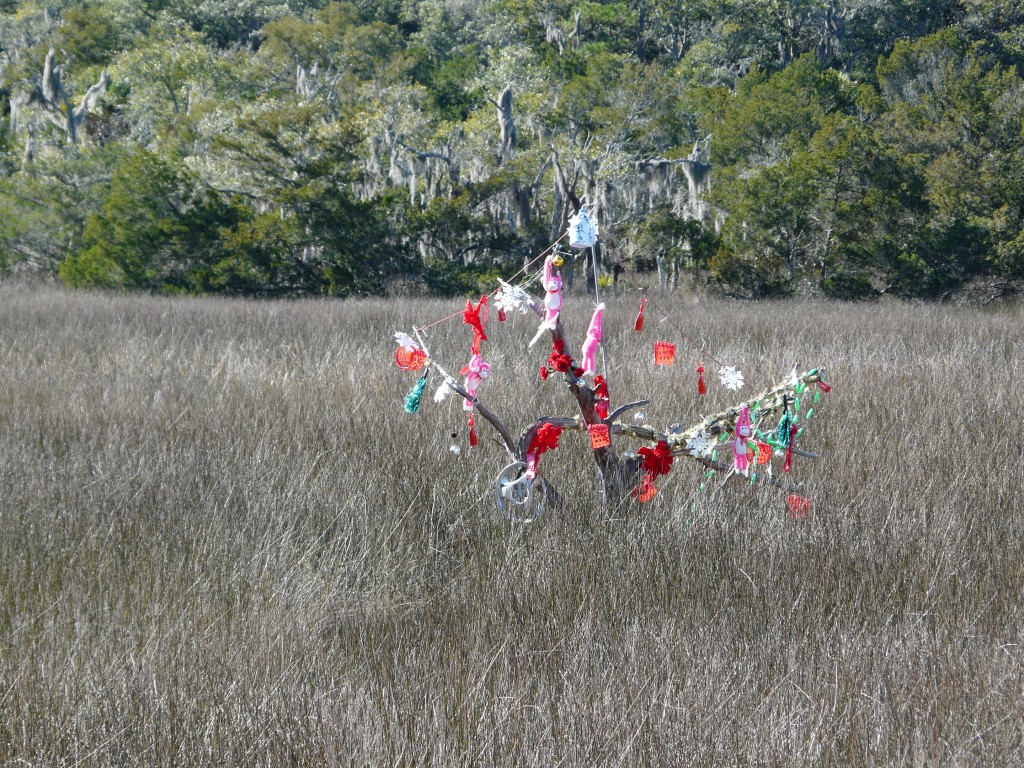
EDISTO ISLAND MYSTERY BOTTLE TREE
I grew up in farmland outside a small town where there were many bottle trees, and many ruined mansions of former plantations. The Civil War did curious things with land and fortunes as the wealth merely rearranged itself and most structures remained intact, but with different names.
Structures like Po’ Pigs, a famous barbeque joint on Edisto Island, where the Sons of the Confederacy still hold their meetings. What is it, exactly, that they miss so much about the era of slavery? Nearly fifty years to the day after the North Carolina lunch counter sit-ins, I entered in blissful ignorance, noting with consternation the sharp look of reproach directed my way from an old man passing through the parking lot. Then I read about the meetings and noted the monochromatic clientele.
I’ve stumbled on this kind of thing before – that strange Southern whatever-it-is that breeds fear and secrecy and segregation. As children looking for an adventurous place to play, we frequently ended up in the abandoned ruins of plantation houses: nameless husks, or now-famous places like Carnton Plantation, where huge blooms of rusty blackened blood were still visible in the floorboards in the 1970s. All kinds of types lurk around these places carrying all sorts of hoods and flags. Returning for the memories.
Growing up as white children in the South, we asked bald questions about the things we saw at these sites: the piles of chains with leg irons we found in the corner of a cellar. Why the slave cabin part of the land filled with grave-size sinkholes and no headstones. Why, when you mention a bloodhound or a coonhound, some people start to get really quiet. What are twilight laws and who enforces them. How come the Confederate flag seems to tag along with fear and hate and violence, no matter what people might say otherwise.
I was lucky to grow up in a tradition where these questions weren’t met with lies, or the whitewashed rhetorical camouflage told to children to obscure their parents’ underlying prejudices.
My grandmother developed a sorrow and contempt for the values of her South Carolina family that extended into the particulars of its slave-owning history. A largely uneducated, deeply rural, and profoundly problematic white Southern woman, my grandmother was known for taking tiny but stubborn and potently outspoken stands against racism and segregation beginning en during her youth in the 1930s. Some of my earliest childhood memories in the 1970s are of her confrontations with small-minded, bigoted neighbors.
She would have perhaps been pleased to learn that in family records, I discovered an ancestor so outraged by the crime of slavery that he left inheritances only to those members of the family who agreed to free their slaves, deed over parts of the land to the freed workers, and leave the Southern states. There were a couple of takers – they moved to Ohio with a small inheritance and started over. But most of them stayed on in South Carolina.
It’s through the fractured lens of this legacy that I learned that there are two kinds of people in the South.
One kind of Southerner passes by a bottle tree, knows what it is, and utters an empty homily about folk art, an adage about the limitations of superstition, or an admonition to take that cheap-ass trash to the dump.
The other kind of Southerner passes by a bottle tree, knows what it is, and the ceiling of the world opens up: they say a prayer, or shake their heads in compassionate sorrow. But they go to a very deep place inside the blood where only iron dwells.
Something deeply wrong has happened here. Good people are trying to survive. Godspeed.
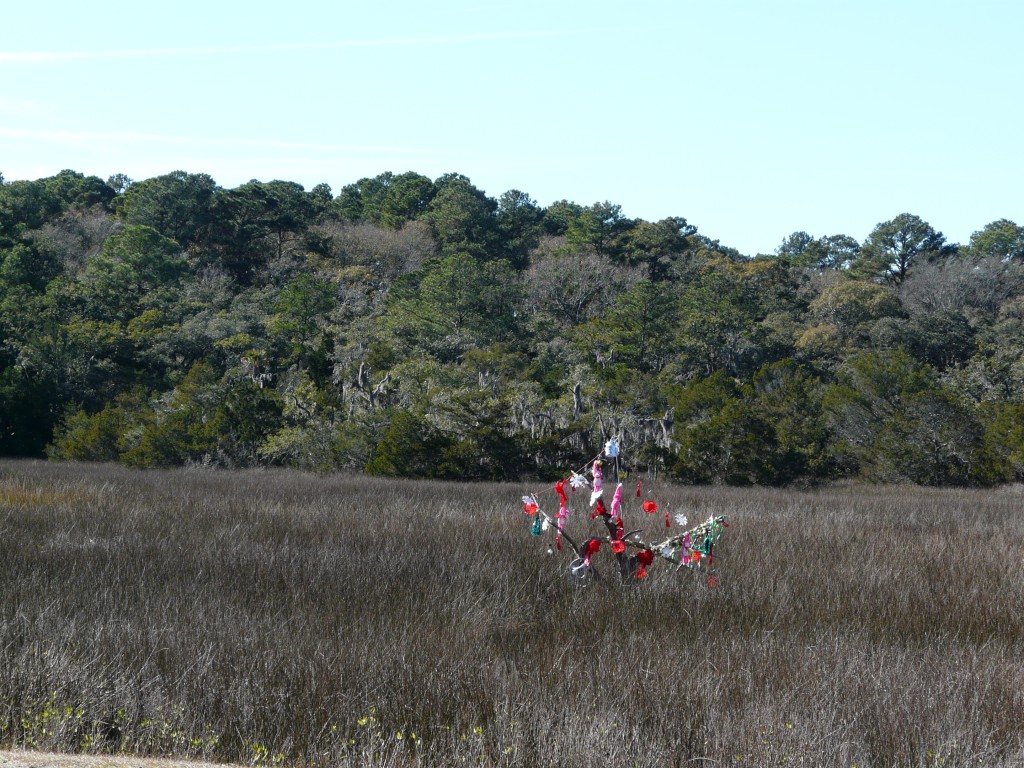
EDISTO MYSTERY BOTTLE TREE
On Edisto, the bottle tree guards that main lane to Bleak Hall, where in the dark shadows of the oaks and the slave cabins, how many hundred women and girls were raped? How many lives were annihilated?
We’ll never know, because they weren’t allowed to read or write, and the rapists wrote the history books.
In American history, these particular crimes against humanity are unparalleled – both slavery itself, and the appalling lack of a proper recognition of the crime. America as a nation can share the blame – not just the South. But when it comes to historical recognition in situ, right there at the sites of slavery, there is a clear duty to mark it. A responsibility of guardianship, of respect to those who suffered crimes, and their family who return to pay respects.
61,590 visitors came to Botany Bay Plantation in 2009, and to my knowledge not a one of them received any information talking about the tragedy and injustices of slavery that happened on those lands.
We have a responsibility to tell the full and complete stories of Bleak Hall, about the family who during the war would famously hunt black people on the plantation grounds, leaving their bodies to decay into the dirt. Not far from the bottle tree.
There is a lot of effort to sustain the vibrant Gullah culture on the Sea Island: a limitlessly rich Creole culture that survived in spite of, despite, because of, instead of..
I can’t help but think what fractional, belated but still significant justice would be done the Gullah community if there were not so many folks on Edisto Island who feel the brazen right to openly conduct the rituals they call “Celebrating the Golden Age of the Island” – the 1800s until the Civil War.
It’s a sickness the Island should surely be healed from. Hasn’t it been spreading for enough centuries already? That poisonous claim that it’s a purely glorious, romantic time whenever human beings are legally allowed to rape, torture, work to death, sell, kill and forcibly breed other human beings in the name of personal profit.
Hosting one-sided, all-white laudatory celebrations of this era is a flagrant perpetuation of bigotry.
Imagine if contemporary Germans offered tours of the Nazi Golden Age, with tours of the cleverly-designed ovens, the gorgeous views from the guard towers, the expert markmanship of the firing squad, and nostalgia for the charming odor of Jew that hung over the land like the sweet, sweet smell of jasmine.
But that’s not what happens. The camps are used as teaching tools, as memorials, as moral markers saying never again.
It is disgusting and disgraceful and abominable that “plantation tours” are used as opportunities to celebrate the decorative Georgian cornices, and the cooling relief of a spring house, and the lovely spring foliage on the pecan trees, and the scent of slave-planted camellia bushes.
Who in their right mind would consider giving a “Spring Garden Tour” of Dachau?
Where a docent costumed as an SS guard would conclude by offering a shot of schnapps beside the crematorium?
With flyers that describe the ways in which the prison barracks both defined and refuted Bavarian architectural traditions in floorboard patterning?
Where the local schnitzel parlor and baby back rib shop (conspicuously empty of Jews) boasted an open publicity campaign by the local Sons Of The Reich chapter– local descendents of SS and Gestapo officers who had worked at the extermination camps.
Why, that would be considered deeply evil.
Huh.
Southern plantations were killing fields. They were torture chambers. They were and are sites of human rights abominations and unfathomable human suffering and injustice. My ancestors were there. They knew, clearly, that what they did was wrong – their wills testify to its immorality.
And despite a war, and despite a 20th century of perpetual bloodshed – year after year after year, we as a country allow plantations to be preserved and publicized as places of romance, honor, and faded glory.
When you look up Bleak Hall Plantation, and its tag line is “an excellent representative of Gothic Revival architecture” and not “a powerful place for American dialogue about the rights and dignity of humanity.”
What is wrong with us.
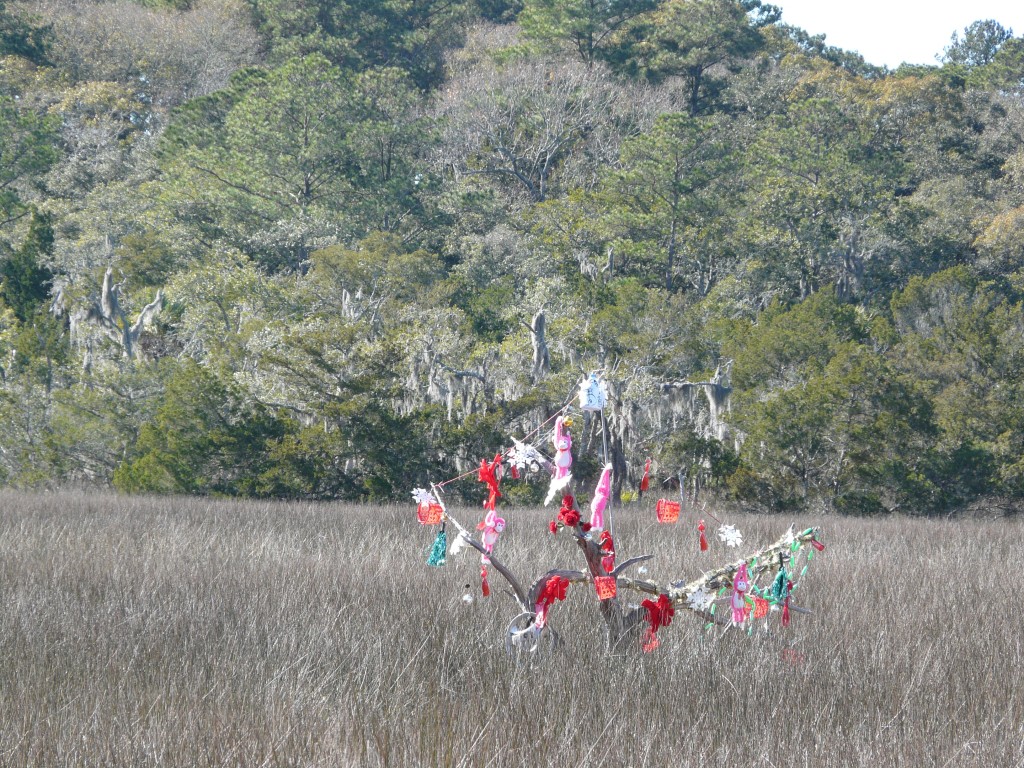
EDISTO ISLAND MYSTERY BOTTLE TREE
And finally – a bottle tree on Edisto Island.
I came home and begin doing internet research on this bottle tree – I believed I would find all sorts of people talking about the beauty and power and placement of this bottle tree. I haven’t. It’s not recognized as a bottle tree. It’s recognized as a “mystery tree.”
I wonder, have I mistaken it for something it is not?
There’s a lot of talk about how nobody knows who decorates it, or when, or why.
Clearly, SOMEBODY knows.
Who puts it up there? I am curious.
There seems to be great interest by weekend second-housers from Clemson. Is it a new transplant to Edisto, making yard art decorations in an accidentally important location?
Could anyone truly be willfully blind or cheerfully oblivious or innocently unaware of the atrocious spot of earth it demarcates? The National Trust of Historic Preservation says the Gullah/Geechee coast is one of the eleven Most Endangered Historic Sites in America because conditions on the Islands are encroaching on the Gullah communities, and will result in the extinction of the culture, its language and customs.
Extinction. Conditions. Hm.
There is an outstanding all-American civil rights heritage on Edisto that could and should be celebrated – that would also fulfill the desire for something Southerners could be proud of. A way to emphasize the positive. Maybe the barbeque restaurants could step up to the plate on that one.
I hope that whoever put up the Edisto Mystery Tree are compassionate, valiant, wise people with a compassionate understanding of the nature of pain, who realize that suffering such injustice requires, demands and deserves a memorial that points out the path that evil once travelled.
I hope one day someone will tell me more about the bottle tree, and I hope it’s something I want to hear: that it’s human beings calling out to other human beings to have a conscience.
Plantations are not amusement parks. They’re not gardens. They’re not entertainment. They’re not glorious, or charming, or romantic. They are not to be celebrated. They are not to be admired for their architecture or groundskeeping.
By whitewashing the bigotry and racial violence of their glory days is to inflict further pain upon people who have sustained too much already. The Edisto Island Museum has a currently-unmet responsibility to become a leader in civil rights education about the role of slavery and the vibrancy of Gullah culture during the lauded Golden Age. Botany Bay Plantation needs to step forward and educate visitors about the exploitation of human beings that took place on that land.
I understand the urge to honor one’s ancestors, but talking about plantations during the 19th century without talking about the crimes of slavery is telling only part of the story – it’s perpetuating a fantasy at best, and a lie at worst.
Is indulging this fantasy worth the cost of causing pain to the survivors of slavery? If they really were so wonderful to the human beings they enslaved, I’m sure they would welcome any contemporary effort to honor those slaves’ descendants.
This is about cruelty, and inhumanity. When we don’t recognize it, we perpetuate it, and we’re complicit in it.
Plantations are as potent a warning as a concentration camp. This is within us. This cannot happen again. This cannot be taken lightly.
May we donate our money and time and sympathies to organizations that work to sustain the Gullah culture and heritage, and to further explore, document and teach a more accurate history of all the people in the early days of America.
May we all build a bottle tree to capture the things that dwell around us and lead us away from wisdom and courage and compassion and kindness.
May we hold it there in the bottle, and then set it clearly in the light.
*
CHECK OUT PENN CENTER: http://www.penncenter.com/
*

Slavery was an abomination. The majority of Southern people did not own slaves. Some people who did own slaves did treat them well.
Some Southerners want to remember their roots and ancestors, just
the way Northern people and African people do. Slavery was wrong. It was wrong in Biblical times and it is still wrong today
in parts of the world where it is still going on. It is not easy
to go back in time and know what people believed about black people. There was a time in history when people were barbarians.
Anyway, these are just a few thoughts. It is not right to own people and especially not right to mistreat them. It is also not right to condemn a whole population for the actions of some people.
The people who committed the early wrongs of slavery are long gone, but the effects of their actions remain. I think there are opportunities for Southern communities to collectively work to heal these lingering sorrows, even though they were caused by others. This is why I mention certain contemporary Germans as an example – they are not personally responsible for the crimes of the Nazis, but they live on land that bears a painful history, and thus they are stewards of a painful socio-cultural legacy. This stewardship is not easy: it requires bravery and a certain stoicism. Rather than approaching this stewardship with fear and defensiveness, many have learned to serve the world as healers. And thus they break the cycle of pain, rather than perpetuate it. I hope that the South can one day reach a similar point in its cultural evolution.
I came across your “Mystery tree’ while collecting pictures of other peoples bottle trees to show to my northern and out of country friends on line. I just put one up in my yard and they thought it was some cute folk art thing ‘I’ came up with. All of them well edcuated writers of folk fiction and song. I was appalled they didn’t know its African roots, its slave history or its current use, how those who know often tell neighbors its ‘folk art’ and supposed to bring good luck. But we who build them know how deep the roots of a bottle tree really run. So I am “educating” them. Hope you don’t mind if I point them to your site. I loved your tree and I noted the bleach bottle on the top had a sigel on it. can’t quite make it out but it looks like one for either a voodon or African deity. Given the colors its also to not just defend (red) against the evil, but actively hold it at bay ( black) or transform ( green) it and send it back to the other side ( white.) Much more than the traditional blue glass bottles do. This is a work for healijng and binding and settling of souls. Something to protect outsiders from the rage of the unsettled dead, as well as to keep the evil which caused it contained and hopefully buried deep. Hopefuly in time that little monument will help send lost souls back across to the other side and peace. I for one am relieved and heartened to see it. Whom ever planted the ‘seed’ of that ‘mystery’ bottle tree. Rock on!
I came across your site while checking out Botany Bay for our trip to Edisto in a few weeks. Thank you for sharing. We are very excited about the natural beauty of the area. We’ve seen photos and can’t wait. But, my family is a great lover of history (my son’s a graduating history major), and after reading your article our walks along that ground will be a more solemn and hopefully honoring walk than it would have been before. I grew up in and am from the state of Indiana. I’m sure there’s much about southern culture that I don’t know, but my eyes will be open for the ‘bottle trees’ as we travel through Edisto and it’s surrounding areas.
a friend reminded me of your post. today he reminded me in the wake of the shooting of Sen Pickney and members of the Emanuel African Methodist Episcopal Church. i yearn to see a huge bottle tree raised to honor them.
I just came across your sit, after researching Gullah/geechie bottles. My grandmother owned one. It was given to her by her mother. She cherished the “decorative,” blue bottle–like nothing else. It was her mother, personified. As she became older and frail, she still protected it. My sister downsizing, thought it was junk–not respecting its origin, or believing it trashed it; whereas, I cherished it. It was my genie-bottle. As a small child, I imagined it as magical. …and now I know it was.
Thank you for your post.
I was driving down the freeway and saw this strange roadside monument, after googling it, I stumbled upon this article, this with some other research led to a profound stay on Edisto. Thank you for writing it.
Edisto is such an important resonant place. It’s good to know that the bottle tree is continuing to do its work. Thanks for reading.
What a loss…but I think bottles from bottle trees do their work long after they’ve moved on. That memory is a blasting. Thank you for reading my piece.
I agree. At this time of renewed attention to the violence against African Americans, a bottle tree project would have significant impact. What a good idea.
Bearing witness and honoring and mourning at that site is so important. It should never be forgotten. I’m pleased to hear that the beauty and the anguish were both honored during your visit. Thank you for reading my piece.
Very interesting!! I didn’t see the sigils. Thanks for writing and thanks for reading. All this is a group effort of self education, memory and action…history is the path that brings us to the present, as we now see in current events in the US. All best wishes to you